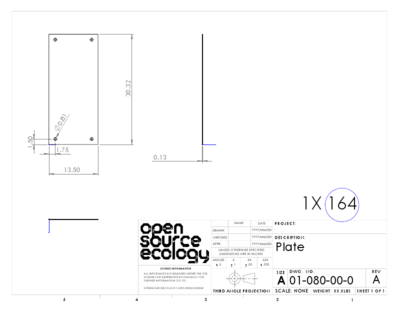TorchTableToolChainTesting: Difference between revisions
Jump to navigation
Jump to search
| Line 14: | Line 14: | ||
[[file:164_plate.png|400px]] | [[file:164_plate.png|400px]] | ||
<pre> | <pre> | ||
/* 164_plate.escad */ | /* 164_plate.escad, units=inch */ | ||
p164_wd = 13.5; | p164_wd = 13.5; | ||
p164_ln = 30.32; | p164_ln = 30.32; | ||
square([p164_wd, p164_ln]); | holedia = 0.81; | ||
</pre> | inset_x = 1.75; | ||
inset_y = 1.5; | |||
difference() { | |||
square([p164_wd, p164_ln]); | |||
union() { | |||
translate([inset_x, inset_y]) circle(holedia/2); | |||
translate([p164_wd-inset_x, inset_y]) circle(holedia/2); | |||
translate([inset_x, p164_ln-inset_y]) circle(holedia/2); | |||
translate([p164_wd-inset_x, p164_ln-inset_y]) circle(holedia/2); | |||
} | |||
}</pre> | |||
run implicitCAD's extopenscad program | run implicitCAD's extopenscad program | ||
<pre> | <pre> | ||
| Line 27: | Line 36: | ||
</pre> | </pre> | ||
Unfortunately, the out.svg file does not contain any clues that the units are inches, and if we open this file with inkscape it will assume user units are pixels. Based on [http://stackoverflow.com/questions/1346922/svg-and-dpi-absolute-units-and-user-units-inkscape-vs-firefox-vs-imagemagick this posting] I found that user units can be forced to inches by substituting a few lines near the beginning of the svg file. Here is a diff | |||
<pre> | <pre> | ||
< | 4c4,10 | ||
< | < <svg xmlns="http://www.w3.org/2000/svg" xmlns:xlink="http://www.w3.org/1999/xlink" version="1.1"><g stroke="rgb(0,0,255)" stroke-width="1" fill="none"> | ||
--- | |||
<svg xmlns="http://www.w3.org/2000/svg" xmlns:xlink="http://www.w3.org/1999/xlink" version="1.1"><g stroke="rgb(0,0,255)" stroke-width="1" fill="none" | > <svg xmlns="http://www.w3.org/2000/svg" xmlns:xlink="http://www.w3.org/1999/xlink" version="1.1" | ||
> width="100in" | |||
> height="100in" | |||
> viewBox="0 0 100 100" | |||
> > | |||
> > | |||
> <g stroke="rgb(0,0,255)" stroke-width="1" fill="none"> | |||
</pre> | </pre> | ||
Revision as of 01:44, 3 December 2012
Tool chain experiments for Torch Table programming
Initial tests ChuckH 22:52, 2 December 2012 (CET)
- environment: Windows XP SP3 laptop
- software installation
- inkscape download inkscape 0.48.2, standard Windows exe installer to Program Files/Inkscape
- 'gcodetools download gcodetools v1.7 here and unpack into Inkscape subdirectory per instructions.
- implicitCAD
- Haskell Platform download installer here. Some Haskell packages are not too happy with Windows path name conventions, particularly spaces inside filenames. I installed at C:\Haskell_Platform instead of the default C:\Program Files\Haskell_Platform. However, this may not be necessary.
- download implicitCAD using cabal (see [instructions]), but it does not build properly. (Unfortunately I did not record exactly my sequence of steps here.)
- patch implicitCAD files to enable Windows install. File:ImplicitCADWindowsPatch0.docThis patch made it compile for me, at the cost of disabling PNG output (not necessary for our toolchain) and disabling file includes (probably painful; need workaround).
simple test part
/* 164_plate.escad, units=inch */
p164_wd = 13.5;
p164_ln = 30.32;
holedia = 0.81;
inset_x = 1.75;
inset_y = 1.5;
difference() {
square([p164_wd, p164_ln]);
union() {
translate([inset_x, inset_y]) circle(holedia/2);
translate([p164_wd-inset_x, inset_y]) circle(holedia/2);
translate([inset_x, p164_ln-inset_y]) circle(holedia/2);
translate([p164_wd-inset_x, p164_ln-inset_y]) circle(holedia/2);
}
}
run implicitCAD's extopenscad program
extopenscad 164_plate.escad out.svg
Unfortunately, the out.svg file does not contain any clues that the units are inches, and if we open this file with inkscape it will assume user units are pixels. Based on this posting I found that user units can be forced to inches by substituting a few lines near the beginning of the svg file. Here is a diff
4c4,10 < <svg xmlns="http://www.w3.org/2000/svg" xmlns:xlink="http://www.w3.org/1999/xlink" version="1.1"><g stroke="rgb(0,0,255)" stroke-width="1" fill="none"> --- > <svg xmlns="http://www.w3.org/2000/svg" xmlns:xlink="http://www.w3.org/1999/xlink" version="1.1" > width="100in" > height="100in" > viewBox="0 0 100 100" > > > > > <g stroke="rgb(0,0,255)" stroke-width="1" fill="none">
